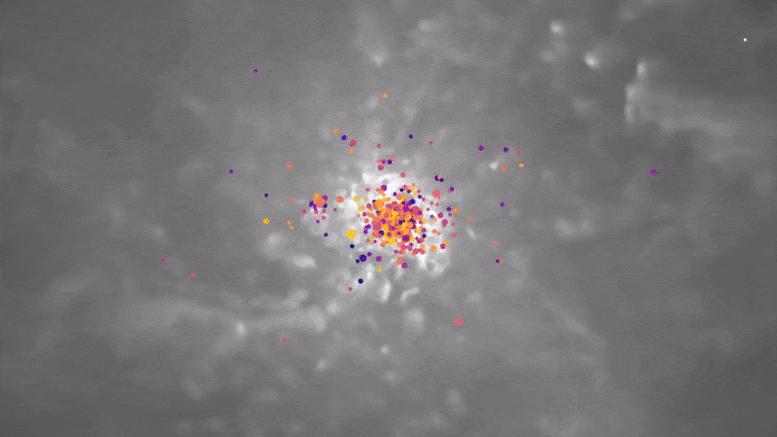
Milky Way Family Tree
Galaxies like the Milky Way formed by the merging of smaller progenitor galaxies. An international team of astrophysicists led by Dr. Diederik Kruijssen from the Centre for Astronomy at Heidelberg University has succeeded in reconstructing the merger history of our home galaxy, creating a complete family tree. To achieve this, the researchers analyzed the properties of globular clusters orbiting the Milky Way with artificial intelligence. Their investigations revealed a previously unknown galaxy collision that must have permanently altered the appearance of the Milky Way.

Globular clusters are dense groups of up to a million stars that are almost as old as the universe itself. The Milky Way hosts over 150 of such clusters. “Many of them came from smaller galaxies that later merged to form the Milky Way that we live in today,” explains Dr. Kruijssen. To study the merger history, the Heidelberg researcher and his colleague Dr. Joel Pfeffer of Liverpool John Moores University (United Kingdom) and their research groups developed a suite of advanced computer simulations, called E-MOSAICS. These simulations include a complete model for the formation, evolution, and destruction of globular clusters.
The German-British team used these simulations to relate the ages, chemical compositions, and orbital motions of the globular clusters to the properties of the progenitor galaxies in which they formed, more than ten billion years ago. By applying these insights to groups of globular clusters in the Milky Way, they not only determined how massive these progenitor galaxies were, but also when they merged with our home galaxy.
Movie of one of the E-MOSAICS simulations, showing the formation of a Milky Way-like galaxy. The grey shading shows gas fragmenting, forming stars, and falling onto the central galaxy. Newborn stars blow bubbles into the gas with their intense radiation and supernova explosions. The globular clusters are indicated by colored dots, where the color indicates the chemical composition: blue clusters have a low level of elements more massive than helium, whereas red clusters have a high level of such elements. Over time, the merging of the central galaxy with smaller, satellite galaxies brings in a large number of globular clusters. The ages, chemical compositions, and orbits of these clusters reveal the mass of the progenitor galaxy that they originally formed in, as well as the time at which it merged with the central galaxy. Together, these enabled the family tree of the Milky Way to be deciphered. Credit: J. Pfeffer, D. Kruijssen, R. Crain, N. Bastian
“The main challenge was that the merger process is extremely messy, because the orbits of the globular clusters are completely reshuffled,” explains Dr. Kruijssen. “To overcome this complexity, we developed an artificial neural network and trained it on the E-MOSAICS simulations. We were astonished at how precisely the artificial intelligence allowed us to reconstruct the merger histories of the simulated galaxies, using only their globular clusters.” The researchers then applied the neural network to groups of globular clusters in the Milky Way and precisely determined the stellar masses and merger times of the progenitor galaxies. They also discovered a previously unknown collision between the Milky Way and an unknown galaxy, which the researchers named “Kraken.”
“The collision with Kraken must have been the most significant merger the Milky Way ever experienced,” Dr. Kruijssen adds. Before, it was thought that a collision with the Gaia-Enceladus galaxy some nine billion years ago was the biggest collision event. However, the merger with Kraken took place eleven billion years ago, when the Milky Way was four times less massive than today. “As a result, the collision with Kraken must have truly transformed what the Milky Way looked like at the time,” explains the Heidelberg scientist.
Taken together, these findings allowed the team of researchers to reconstruct the first complete family tree of our home galaxy. Over the course of its history, the Milky Way cannibalized about five galaxies with more than 100 million stars, and about ten more with at least ten million stars. The most massive progenitor galaxies collided with the Milky Way between six and eleven billion years ago. Dr. Kruijssen expects that these predictions will aid the future search for the remains of the progenitor galaxies. “The debris of more than five progenitor galaxies has now been identified. With current and upcoming telescopes, it should be possible to find them all,” the Heidelberg researcher concludes.
The research results were published in Monthly Notices of the Royal Astronomical Society.
Reference: “Kraken reveals itself – the merger history of the Milky Way reconstructed with the E-MOSAICS simulations” by J M Diederik Kruijssen, Joel L Pfeffer, Mélanie Chevance, Ana Bonaca, Sebastian Trujillo-Gomez, Nate Bastian, Marta Reina-Campos, Robert A Crain, Meghan E Hughes, 17 August 2020, Monthly Notices of the Royal Astronomical Society.
DOI: 10.1093/mnras/staa2452
Never miss a breakthrough: Join the SciTechDaily newsletter.
3 Comments
It’s obviously the quantuum fluctuations of the Milky Way galaxy displaying itself… Milky Way, Show cow Source of milk. Me understand now, thanks Vishnu. 🙂
Another dward galaxy incorporated now has just been discussed: Heracles. See https://scitechdaily.com/astronomers-discover-new-fossil-galaxy-buried-deep-within-the-hidden-depths-of-our-own-milky-way/
magnificent and heavenly Are the words that come to mind